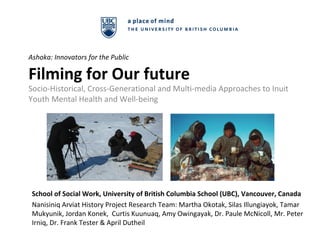Filming for our future
- 1. Ashoka: Innovators for the Public Filming for Our future Socio-Historical, Cross-Generational and Multi-media Approaches to Inuit Youth Mental Health and Well-being School of Social Work, University of British Columbia School (UBC), Vancouver, Canada Nanisiniq Arviat History Project Research Team: Martha Okotak, Silas Illungiayok, Tamar Mukyunik, Jordan Konek, Curtis Kuunuaq, Amy Owingayak, Dr. Paule McNicoll, Mr. Peter Irniq, Dr. Frank Tester & April Dutheil
- 2. Nanisiniq Arviat History Project âĒ Inuit Elders & youth from Arviat, Nunavut âĒ Two year multi-media history project âĒ Participatory action research âĒ Sivulinuut Elders Society & University of British Columbia School of Social Work
- 3. Arviat, Nunavut âĒ 1,200 kilometers north of Winnipeg âĒ Third largest town in Nunavut âĒ Population approx. 3,000
- 4. Inuit History âĒ Most dramatic assimilation period in history âĒ Relocation âĒ Starvation âĒ Residential school âĒ An attempt to assimilate Inuit into western culture Tester & McNicoll (2004)
- 5. Mental Health and Well-being âĒ Arviat: 74% of population under 25 years old compared to 35% for general Canada âĒ Arviat: Highest national birth rate â 35/1,000 âĒ Nunavut suicide eight times the rate of suicide in southern Canada â 119.7/100,000 vs. 14/100,000 âĒ Socio-historical trauma & fractured identity/belonging Hicks (2004); Tester & McNicoll (2004); White (2010)
- 6. Generational Gap âĒ Decreased interaction between Elders and youth âĒ Impacts grasp of culturally, socially and geographically -relevant Inuit knowledge
- 7. Forgotten History âĒ Limited understanding of Inuit history among youth âĒ Inuit history not taught in Nunavut (or southern Canada) âĒ Painful to talk about
- 8. History & Identity âĒ Knowing oneâs history to make sense of personal & community experiences âĒ Rediscovering, celebrating & re- enforcing identity
- 9. History & Resistance âFirst of all I'd like to say that Inuit were treated back then as if they were stupid. They knew how to hunt well and how to survive on the land but then, what did they get? White people writing them a book of wisdom which Inuit already had! From reading the documents we have been looking at, Inuit stayed quiet and tried to listen to the White people...What the white people did not know then was Inuit were already smart enough to live their lives...â -Amy Owingayak, August 22 2010
- 10. Elders âĒ Cross-generational dialogue & understanding âĒ Culturally & socially reaffirming for Elders & youth âĒ Healing generational trauma
- 11. Elders & Strength âI'm amazed by these Elders I'm watching who were all mistreated by the Canadian Government - Yet they still stand strong. I'm even more amazed how they know the environment around them. We're losing it.â -Jordan Konek, August 2 2012
- 12. Filmmaking
- 14. What does this project mean to me?
- 15. Acknowledgements âĒ Social Sciences and Humanities Research Council of Canada âĒ Sivulinuut Elders Society âĒ Nunavut Research Institute âĒ Nunavut Arctic College
- 16. References âĒ Hicks, J. (2004, January 24). Nunavut Kiglisiniaqtiit: Evaluation and Statistics. Presentation to the Founding Conference of the Nunavut Suicide Prevention Council, Iqaluit, NU. âĒ Korhonen, M. (2006). Suicide prevention: Inuit traditional practices that encouraged resilience and coping. Retrieved from the Ajunnginiq Centre, National Aboriginal Health Organization website: http://www.naho.ca/inuit/e/resources/documents/SuicidePr evention-FinalEnglish_000.pdf âĒ Tester, F. J., & McNicoll, P. (2004). Isumagijaksaq: Mindful of the state: Social constructions of inuit suicide. Social Science & Medicine, 58(12):2625-2636. âĒ White, Patrick (2010, June 5). Inuit mothers fight for their childrenâs health. The Globe and Mail. Retrieved from http://freeinternetpress.com/story.php?sid=25989
- 17. Questions âĒ Blog: Nanisiniq.tumblr.com âĒ Twitter: @NanisiniqArviat âĒ Email: Nanisiniq@yahoo.ca
Editor's Notes
- #2: -explain that âAre you Rich?â was already presented at IPY, but the final slides are online at Nanisiniq.tumblr.com -explain that youâre here presenting on behalf of a team
- #3: -Outline three topics weâre going to cover, implications for public health & health research: Mental health & wellness among youth, intergenerational connectedness, history, knowledge translation. -Asset-based approach
- #4: -audience participation: who here can tell me where Arviat is?
- #6: -Mental health is an important, yet currently minimally addressed issue in the Canadian North. Suicide rates in Nunavut are eight times the rate of those in southern Canada (Tester & McNicoll, 2004). The Baffin region of Nunavut has the highest male suicide rate at 133.9/100,000 and the highest female suicide rate at 47.1/100,000 (Tester & McNicoll, 2004). In the Baffin region as well as other regions of Nunavut, the prevalence of Inuit male (ages 15-29) suicide is among the highest in the world (Tester & McNicoll, 2004).
- #9: -Trained Inuit youth as historical researchers- examined archival document, pictures & film footage from the eastern Arctic, 1935-1970 -Many Inuit now living in Arviat underwent dramatic relocation from Ennadai Lake to Eskimo Point, now Arviat- starvations, TB, relocations -more of a change from one physical location to another, but attempts for psycho-social assimilation -History for healing
- #10: -History as a foundation for understanding -resistance
- #11: -I hear a lot of discussions of health at this conference that is defined as a lack of disease, but would argue that mental health & wellness is central to health for Inuit -Good relations are central to wellbeing and health in Inuit communities -if you have good relations, everything else is bearable & good -Working together
- #13: -knowledge translation- Zach Kunuk, said that the Video Camera is the best tool for research with Inuit communities -skills-based training, supports youth with employable skills- all youth involved went on to receive work in filmming, education, youth work -Participatory Filmmaking (resistance against dominant culture & TV/Internet) -creates space of resistance in research-relationships -implications participatory policy making
- #14: -educating researchers, communication & relationship building -Social media -Mention âMy Wordâ storytelling project
- #15: -implications for Nunavut Arctic College & high school systems
- #16: -Funded by the Social Sciences and Humanities Research Council of Canada
- #18: -Add blog site

















